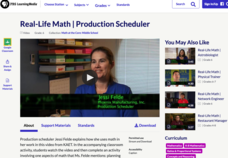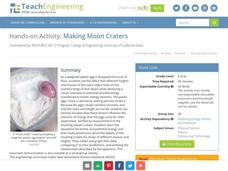New Mexico State University
Ratio Rumble
Develop a potion of ratios. Learners play a matching game to make potions that follow a recipe. Pupils create equivalent ratios to make multiple recipes at a given time. As levels increase, ratios get more difficult, as they include...
CK-12 Foundation
CK-12 Middle School Math Concepts - Grade 6
Twelve chapters cover a multitude of math concepts found in the Common Core standards for sixth grade. Each title provides a brief explanation of what you will find inside the chapter—concepts from which you can click on and learn more...
Purdue University
Food Waste Solutions
Easy doesn't always mean better. In an era with pre-packaged everything, learners consider the environmental impact of the convenient trend. They critique the packaging of food and how waste impacts cost and then look for solutions.
CK-12 Foundation
Properties of Rational Numbers: Lollipop Trees
A six-question interactive takes mathematicians to Lollipop Land where they manipulate lollipop trees to make equivalent ratios. Question types include multiple-choice, true or false, and a discussion.
Purdue University
Design of a Reindeer Habitat for an Indiana Zoo
What would Rudolph ask for in his ideal home? Pupils analyze the characteristics of the reindeer to create their perfect zoo habitats. A STEM lesson focuses on the design of the habitat while factoring constraints such as space, diet,...
PHET
Proportion Playground
Ratios are all around you. A fun interactive has scholars investigate ratios and proportions in different situations. These include creating bracelets with different ratios of beads, mixing paint, adjusting the length and width of a...
CCSS Math Activities
Smarter Balanced Sample Items: 6th Grade Math – Target A
Only in math problems do people buy 18 cans of tennis balls and no one wonders why. Scholars solve for the number of total tennis balls given the ratio of balls per can. This and other ratio word problems in a PowerPoint from Grade 6...
PBS
Atlantean Dodgeball
Which team has the advantage? An imaginary story about a game of dodgeball in the lost city of Atlantis demonstrates the ways to compare two quantities. One coach compares the ratios of the numbers of players on each team while the other...
PBS
KidVid: Fractions and Scale
Scale the challenge of learning about ratios and scales. Young mathematicians learn to incorporate fractional measurements when considering scales and scale factors. They use an interactive to investigate the concept and critically...
PBS
KidVid: Equivalent Ratios
There's no equivalent to this interactive. To learn about equivalent ratios, scholars first watch a video of a pupil trying to find an equivalent ratio. They consider whether the pupil is correct and explain their reasoning. Then, they...
PBS
Super Bear: Comparing Mass
A super bear is a whole lot of gummy bear. Scholars hone their estimation skills by completing an activity. Given the masses of a mini gummy bear and a regular gummy bear, they must determine the number of each needed to have the same...
PBS
Soul Food Junkies: Portions
Serve up a rate of percents. The Math at the Core resource investigates the percent of daily value of sodium and saturated fats in different foods. Pupils determine the number of serving sizes they eat of popular snack foods and...
PBS
Math with Jake: Ratios and Fractions
And the beat goes on. The installment of the Math at the Core: Ratios series introduces time signatures in music. A musician shows the relationship between different types of musical beats. Working in pairs, classmates create beat...
PBS
Real-Life Math — Production Scheduler
Use unit rates to find the number of parts needed to produce a given number of units. A production scheduler shares the different ways schedulers use math to ensure the required amount of parts are available to manufacture air...
PBS
Math with Jake: Transposition Using Ratios
The star of the show is ratios. The informative resource explains how to transpose music using ratios. Individuals transpose the song "Twinkle, Twinkle" in the activity by applying their ratio skills. The activity challenges class...
PBS
Scale City — Proportional Relationships in the Real World
Strive to determine your stride. Scholars first view an informative video on the Kentucky Horse Park and the 28-feet stride of the Man o' War. They then work together in groups to find the length of their own strides by using the number...
PBS
The Lowdown — Exploring Changing Obesity Rates through Ratios and Graphs
Math and medicine go hand-in-hand. After viewing several infographics on historical adult obesity rates, pupils consider how they have changed over time. They then use percentages to create a new graph and write a list of questions the...
Teach Engineering
The Building Blocks of Matter
Everything can be reduced to atoms. The first installment of a six-part Mixtures and Solutions unit focuses on the building blocks of matter. Scholars review basic atomic structure, including protons, neutrons, and electrons, in...
Teach Engineering
Bend That Bar
Bend it, but don't break it. Groups investigate the strength of different materials. Using a procedure in the seventh segment of a 22-part series on aviation, pupils determine how far a rod will bend. They determine the strength-to-mass...
Teach Engineering
Exploring Energy: Energy Conversion
The energy is not really lost, it is just converted to a different form. Pupils learn about the conversion of energy in the fifth segment of an energy unit with six parts. Learners develop an understanding of the conservation of energy...
Teach Engineering
Making Moon Craters
Create an egg-citing study of energy. Pupils investigate the effect of height and mass on the overall amount of energy of a falling object. The fourth segment in a six-part series on energy uses a weighted egg falling from different...
Teach Engineering
Exploring Energy: Kinetic and Potential
The potential of the energy in the class is moving. The third segment in a six-part unit on energy provides a deeper understanding of kinetic and potential energy. Learners understand the relationship between mass, speed, and energy and...
Benjamin Banneker Association
Celebrate Benjamin Banneker
Inventor, astronomer, surveyor, mathematician, clock maker. Learners celebrate the life of Benjamin Banneker by building creative analog clocks, making scale models, and solving problems related to surveying. The activities model the...
Yummy Math
Sweethearts Candy
Sweethearts® candies are a beloved Valentine's Day treat—so much so that eight billion hearts are produced every year around the world! Learners use number sense reasoning and critical thinking to solve nine word problems about the...

























